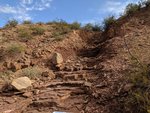



Lots of places like to say they are a hidden gem. But Prehistoric Trackways National Monument really fits that billing.
Nestled away in the Robledo Mountains just outside of Las Cruces, the Prehistoric Trackways contains world-class fossils dating back millions of years.
But the decade-old national monument often goes unnoticed by both local residents and visitors to Southern New Mexico.
Prehistoric Trackways, located about 10 miles northwest of Las Cruces off Shalem Colony Road, preserves about 5,000 acres of unique geology and paleontology.
While the national monument is just a few minutes outside New Mexico’s second largest city, there are no signs guiding your way in. Visitors have to know where they are going and what they are looking for.
But once you find the monument, the enterprising visitor is rewarded with scenic views of desert landscape and mountains and a plethora of recreation options.
“There are beautiful canyons in the interior with bedrock cliffs of yellows, reds and grays that are very striking,” said monument paleontologist Colin Dunn. “Not many people explore the interior, unfortunately. No other place in south-central New Mexico can one so quickly and easily access the special character that this monument has.”
The monument offers about 30 miles of trails for hiking, mountain biking, horseback riding and even off-road vehicles.
But it is mostly known for its fossils, but even those are largely misunderstood.
Many visitors come expecting to see dinosaur bones or fossils, Dunn said.
“There are no dinosaurs, no dinosaur bones or dinosaur footprints,” he said. “It is all before the dinosaurs.”
What you can see -- if you look carefully -- are trace fossils dating back more than 280 million years.
Trace fossils document, in stone, the movements or behavior of animals, insects and marine life that once inhabited the area, Dunn said. They also include impressions of plants that lived millions of years ago too, he added.
“What you usually see are early conifer tree branch impressions,” Dunn said. “Sometimes you will see petrified logs or pieces of petrified wood from those trees, footprints and tail drags from small salamander-like animals, footprints from small running lizards.”
The largest fossil you will see is about the size of your hand and is thought to be from the Dimetrodon, a mammal-like reptile easily recognizable by the large sail on its back, Dunn said.
In addition, you can see spectacular examples of sedimentary formations like mud cracks, ripple marks and raindrop impressions.
The monument was created in 2009 by an act of Congress and is administered by the U.S. Bureau of Land Management.
“Of course, I’m biased, but we don’t have many opportunities to see these type of fossils,” Dunn said. “The preservation style is so great. You would have to travel a long ways to see something like this elsewhere and it is right here in our own backyard. And then you get to learn about the geological history and learn what happened to the Las Cruces area through time.”
You can explore Prehistoric Trackways on your own, but the fossils are small and difficult to find if you don’t know what you are looking for. The monument also has very few interpretive signs to guide your visit.
To make Prehistoric Trackways more user-friendly, the BLM hosts free guided hikes on the third Saturday of every month.
Dunn leads hikers out into the monument and shows them the history and geology of the area, giving a fun crash course on the area.
His guided hikes only touch on a small part of the monument but for the first-time visitor, they are the perfect introduction.
“I do recommend that people come out on the guided hike,” Dunn said.
“The tracks are fairly small and they are very easy to miss. When there is a guide that can point them out, you can really appreciate the value.”
Two of out every three months, the guided hike goes out to the Discovery Site. That’s where Jerry MacDonald found the first significant slab or trackway of fossils in 1987.
This area had long been known for fossils, but MacDonald is largely credited with bringing national and international attention to the trackways.
The hike out to the Discovery Site is about a 3-mile round trip. The trail follows a natural arroyo, making for uneven and sometimes challenging terrain for hikers to traverse.
During the third month, the guided hike takes visitors out to the Site Flood area, where they can see petrified wood and fossils from marine life that have been discovered there. At one time, this area was under an ancient sea.
This hike, also about 3 miles round trip, contains several hills that may be challenging for some hikers.
Some of the trackways have been excavated to protect and study them. Some can be viewed at the Las Cruces Museum of Nature and Science, which serves as an unofficial visitors center for the monument.
Others have been transported to the New Mexico Museum of Natural History and Science in Albuquerque for safe keeping and further study.
Dunn said there are plans to add more interpretive signs at the monument and make improvements to some of the trails.